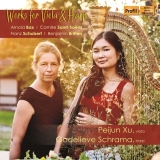 Works for Viola & Harp; Arnold Bax: Fantasiesonate für Viola und Harfe; Camille Saint-Saens: Fantasie für Viola und Harfe op. 124; Franz Schubert: Sonate für Arpeggione und Klavier a-moll D 821 (für Viola und Harfe); Benjamin Britten: Lachrymae op. 48 (für Viola und Harfe); 1 CD Profil PH19069; Aufnahme 07/2019, Veröffentlichung 05/2020 (D), 07/2020 (UK) - (75'06) - Rezension von Remy Franck
Works for Viola & Harp; Arnold Bax: Fantasiesonate für Viola und Harfe; Camille Saint-Saens: Fantasie für Viola und Harfe op. 124; Franz Schubert: Sonate für Arpeggione und Klavier a-moll D 821 (für Viola und Harfe); Benjamin Britten: Lachrymae op. 48 (für Viola und Harfe); 1 CD Profil PH19069; Aufnahme 07/2019, Veröffentlichung 05/2020 (D), 07/2020 (UK) - (75'06) - Rezension von Remy Franck
1926 lernte Arnold Bax die russische Gräfin Benckendorff kennen, eine virtuose Harfenistin. Für sie komponierte er im April 1927 die Fantasiesonate für Bratsche und Harfe. Es ist ein sehr anspruchsvolles Stück, in dem die beiden Instrumente gleichgestellt sind. Die Harfe muss sich also keineswegs mit einer simplen Begleiterrolle abgeben. Prägend sind die Tanzrhythmen, die durchs ganze Werk hindurch auftauchen.
Peijun Xu und Godelieve Schrama spielen die Komposition sehr vital und ausdrucksvoll. Xu spielt die Bratsche wunderschön lyrisch und Schrama reagiert mit einem höchst eloquenten Spiel darauf.
Das Opus 124 von Camille Saint-Saëns ist original für Violine und Harfe geschrieben, aber Xu spielt es problemlos auf der Viola, fantasievoll begleitet von Godelieve Schrama. Beide Künstlerinnen überzeugen auch in Schuberts Arpeggione-Sonate D 821, die für verschiedene Instrumente adaptiert wurde, weil es das Instrument Arpeggione nicht mehr gibt. Hier wird dann auch gleich noch das Klavier durch die Harfe ersetzt. Die Bratsche kommt angeblich dem Originalklang nahe. Xu und Schrama gestalten ein überzeugendes Wechselspiel und machen Schuberts Werk zu einem wunderschönen Lied ‘ohne Worte’.
Brittens reflektives Lachrymae, nach einem Lied von Dowland, beschließt das Programm mit einer sehr spannenden und atmosphärisch dichten Interpretation.
In 1926 Arnold Bax met the Russian Countess Benckendorff, a virtuoso harpist. For her he composed the Fantasy Sonata for viola and harp in April 1927. It is a very demanding piece, in which the two instruments are equal. So, the harp does not have to deal with a simple accompanying role at all. The main characteristic of the music are the dance rhythms that appear throughout the work.
Peijun Xu and Godelieve Schrama’s performance is very vital and expressive. Xu playing is beautifully lyrical, Schrama’s highly eloquent too.
Camille Saint-Saëns’ Opus 124 is originally written for violin and harp, but Xu plays it without problems on the viola, imaginatively accompanied by Godelieve Schrama. Both artists are also convincing in Schubert’s Arpeggione Sonata D 821, which was adapted for various instruments because the instrument arpeggione no longer exists. Here even the piano is replaced by the harp. The viola allegedly comes close to the original sound. Xu and Schrama create a convincing interplay and make Schubert’s work a beautiful song without words.
Britten’s reflective Lachrymae, after a song by Dowland, concludes the program with a very exciting and atmospheric interpretation.
























